13.2.2: Midlatitude Forests
- Page ID
- 16151
Mediterranean Woodland
The Mediterranean woodland is a sclerophyll forest consisting of low branching trees with small hard leaves and gnarled thick bark. The Mediterranean Woodland is found on west coast of continents in the midlatitudes and bordering the Mediterranean Sea, in close association with the Mediterranean (Dry Summer Subtropical) climate. Mediterranean woodland in North America is found along much of coastal southern California.
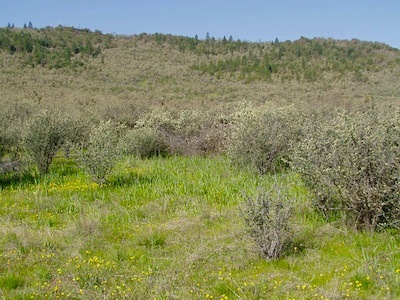
Thick bark and small, waxy leaves are two adaptations to prevent excessive loss of moisture during the severe summer drought experienced in the dry summer subtropical climate. Chaparral vegetation grows to a height of 1 to 3 meters and has leathery leaves to prevent moisture loss. Chaparral has evolved fire-related adaptations as wildfires are common in this environment. Many chaparral species resprout and germinate after a fire. The cones of the Tecate cypress stay closed and on the tree until heat from a fire opens them and releases the seeds. Other species like toyon depend on resprouting from underground root systems that survive after a fire. Canopy of the typically hardwood, evergreen vegetation covers about 25 to 60 % of the terrain. The sparseness of the vegetative cover is due to the severe summer moisture stress and human disturbance.
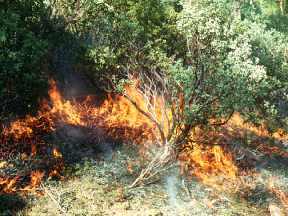
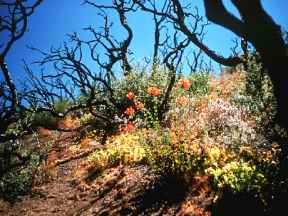
Midlatitude Broadleaf Deciduous and Mixed Forest
The Midlatitude Broadleaf Deciduous and Mixed Forest of the humid midlatitudes contains evergreen and/or deciduous trees reaching heights of 15 to 25 meters. The broadleaf forest dominates equatorward, while toward the north, conifers intermingle to create a mixed forest. Needle leaf trees are well adapted to the cool to cold temperatures which occur on the poleward limits on the humid continental climate. Conifer needles are thicker than broadleaf leaves and have waxy coatings that promote water conservation. The small but large number of needles effectively capture a large percentage of sunlight, especially important during the the winter when sun angles are low. Cold sensitive broadleaf trees enter a period of vegetative dormancy, reducing moisture content and shedding their leaves. Oak, maple, hickory, chestnut and beech are common tree types found in the broadleaf deciduous forest. In most cases the forest is an open forest with little under story growth, though some shade tolerant annual species occupy the ground. The dense canopy inhibits significant amounts of light to penetrate to the forest floor inhibiting growth at ground level.
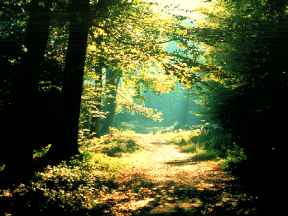
Many stands of different age and tree species are found together lending a patchwork character to the forest. The forest may be comprised of pure stands, or contain 2 to 3 species. Temperate forests are found in the Humid Continental climate and stretching into the Humid Subtropical Climate. Alfisol soils are found developing beneath much of the temperate midlatitude forest. Spodosols are found where conifers dominate.
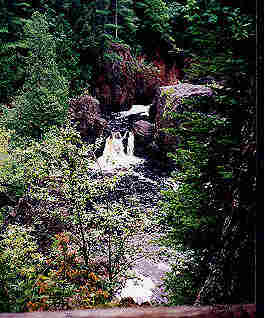
The midlatitude broadleaf deciduous and mixed forest has been drastically changed over time by human activities. By A.D. 1000, China was virtually "treeless". Much of England's forests had been cut by 1700. Today, acid rain threatens the temperate forest in many locations.
Subtropical Evergreen Forest
There are two variants of the subtropical evergreen forest, the broadleaf evergreen and needle leaf subtropical forest. The subtropical broadleaf evergreen forest is found in New Zealand, southeastern Australia, and Southern Chile. Here, mild maritime air masses keep conditions moist enough to suppress any summer drought and provide temperatures warm enough to prevent a threat of frost. Small pockets of broadleaf evergreen species like evergreen oak and magnolia, are found in the United States in Florida and along the Gulf Coast.
The subtropical needle leaf forest is found as a southern pine forest in the southeastern United States. The forest has developed on the sandy deposits along the fringe of the Atlantic and Gulf Coasts.
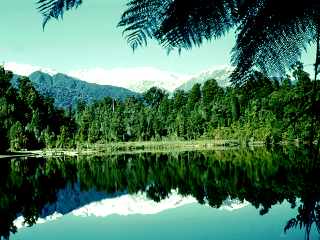
Temperate Rain Forest (Marine West Coast Forest)
The temperate rain forest, or sometimes called the marine west coast forest, is known for its lush vegetation occurring along narrow margins of the Pacific Northwest in North America. However, the temperate forest lacks the diversity that the tropical rain forest has. The rain forest of the Pacific Northwest is composed of a few species of broadleaf and needle leaf trees, huge ferns, and a thick undergrowth. Lying on the windward slopes of the Cascade and Coast Ranges, this forest receives over a hundred inches a year in marine west coast climate, as much precipitation as some tropical rain forests.
The temperate rain forest is home to some of the largest trees and oldest living organisms on earth - the coast redwoods. Exceeding 200 to 300 feet in height and having diameters over 20 feet, these trees can live well over a thousand years. The redwood forest floor is covered and epiphytes dangle from the trees. The cool and shady redwood forests of North America create a habitat for a variety of animals, including the northern spotted owl, Stellar's Jay, banana slugs, Pacific tree frog, and black bear.
Old growth forests of Douglas fir, spruce, cedar and hemlock have been devastated by logging. With only 10% of the original forest left, biodiversity loss is a great concern to ecologists.


